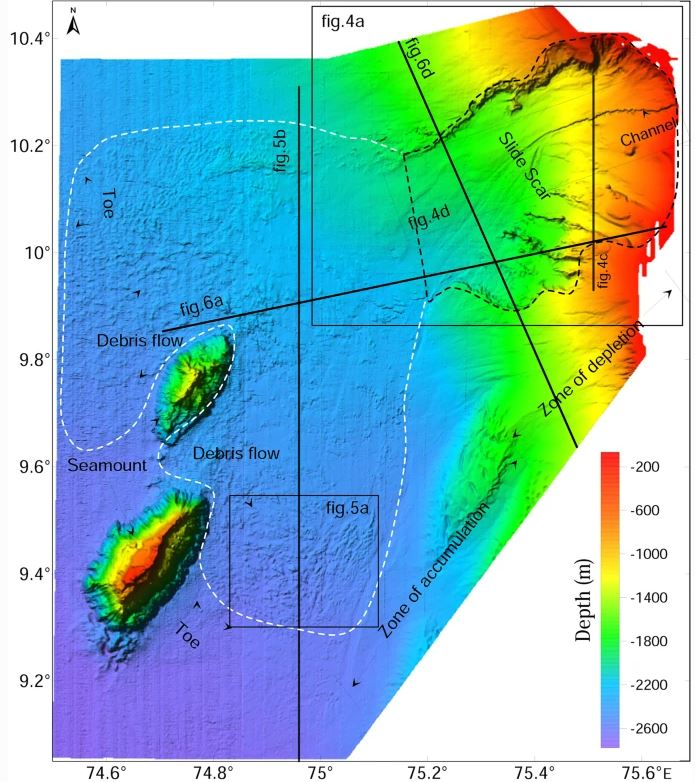5 October 2022
The Cochin slide: a huge submarine landslide
Posted by Dave Petley
The Cochin slide: a huge submarine landslide
I usually write here about landslides on land, but the largest and, in many ways, most impressive failures occur in the oceans. In a paper published in the journal Landslides, Bijesh et al. (2022) describe the Cochin slide, a huge failure that lies in the Cochin offshore region on the southwestern continental margin of India. This is a bathymetric image from the paper showing the landslide:-

High-resolution multibeam bathymetry map of the Cochin slide, from Bijesh et al. (2022). The black dashed line indicates the boundary of the slide scar, whilst the white dashed line indicates the boundaries of the landslide deposit. The colours indicate the water depth as per the key on the lower right side.
.
The statistics of this landslide, as with many other submarine failures, are astounding. The landslide slide scar is 46 km wide, with an evacuated volume of about 240 km³. The gradient of the landslide scar is just 2º. The landslides scar covers an area of about 2,000 km², whilst the landslide deposits extend over about 5,700 km². The maximum runout distance (from the crown of the landslide scar to the toe of the deposit) is about 138 km (for context, the direct distance between New York and Philadelphia is about 130 km).
Whilst landslides on this scale are scientifically fascinating, and there remains a great deal to learn, a key focus is of course on the hazard potential, and in particular the likelihood of such an event generating a tsunami. A key element of this is to understand the likely trigger of such events. In the case of the Cochin slide this is unclear. Bijesh et al. (2022) speculate that key factors could have been “sedimentation, formation of weak layers, and extensive faulting in the shelf/slope region. It is also inferred that the offshore extension of the major lineaments and deep-seated faulting resulting in weak planes and earthquakes in the region have also influenced the triggering of the Cochin slide.”
Whilst the location and volume of the landslide are compatible with a tsunami-generating event, tsunamigenic submarine landslides also require rapid acceleration of the landslide mass and the presence of stiff, cohesive materials. At present it is unclear as to whether these criteria were met by the Cochin slide. Finally, it is not known as to when the landslide occurred.
Further research is required for sure, and Bijesh et al. (2022) have made some suggestions as to what should happen next, including sampling and analysis of the slide deposits; more detailed imaging; modelling; and investigation of the potential role of sea level change in this region. To these I would add further investigation of the tectonics of the area.
This is a great example of a large submarine landslide with potential consequences for coastal communities in the region, as well as for seafloor infrastructure. I shall look forward to reading about subsequent research on this impressive landslide.
.
Reference
Bijesh, C.M., Twinkle, D., Susanth, S. et al. 2022. Large-scale submarine landslide in the Cochin offshore region, southwestern continental margin of India: a preliminary geophysical understanding. Landslides (2022). https://doi.org/10.1007/s10346-022-01969-6


 Dave Petley is the Vice-Chancellor of the University of Hull in the United Kingdom. His blog provides commentary and analysis of landslide events occurring worldwide, including the landslides themselves, latest research, and conferences and meetings.
Dave Petley is the Vice-Chancellor of the University of Hull in the United Kingdom. His blog provides commentary and analysis of landslide events occurring worldwide, including the landslides themselves, latest research, and conferences and meetings.
Santa Cruz sería mucho más grande si. Se acepte como derrumbe. El hecho es que es una masa coherente y no fragmentada como la mayoría de los derrumbes. Su volumen ( 90 x 15 x <2 km) es mucho más grande.